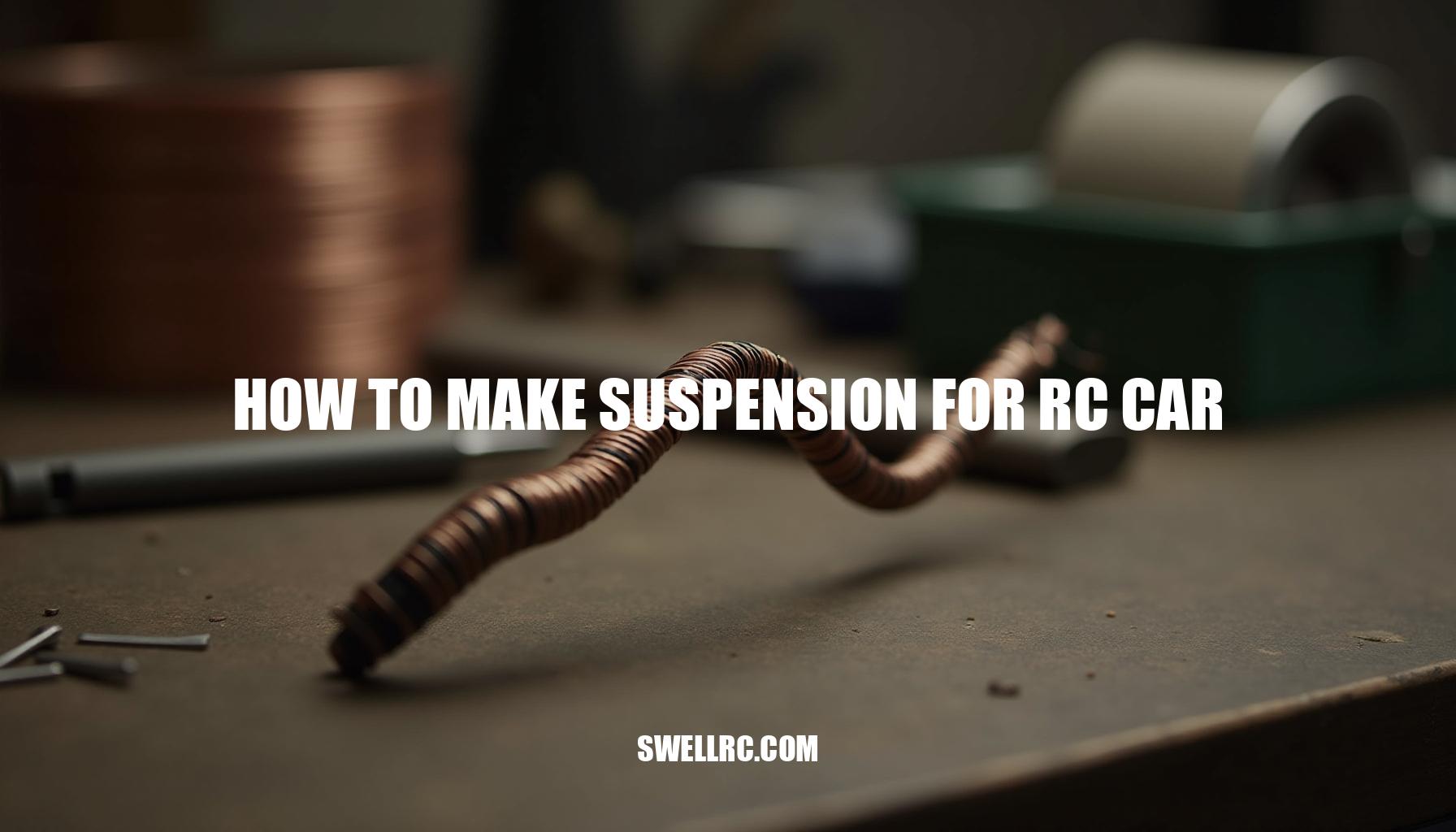How to Make Suspension for RC Car: A Comprehensive Guide
If you’ve been wondering how to make suspension for RC car builds that truly handle, you’re in the right place. After countless hours of tinkering with springs and shock absorbers, I finally felt that “click” when the damping and ride height lined up—and the car flowed over washboard bumps like butter. Achieving the perfect RC suspension involves understanding key design principles, selecting the right materials, and performing precise RC tuning.
We’ll explore everything from coil-over shocks to independent suspension setups that improve your RC chassis flexibility, allowing your vehicle to adapt seamlessly to varied terrain. Whether you’re fine-tuning your suspension setup for smoother rides or customizing shock absorbers for optimal performance, this guide walks you through an at-home build process that’s achievable with basic hobby tools and a little patience. Let’s dive in and craft a suspension system that perfectly matches your driving style and off-road challenges.
Understanding RC Suspension: The Science Beneath the Thrill
RC suspension plays a crucial role in keeping your tires planted firmly on the surface, effectively absorbing impacts and stabilizing your chassis during acceleration, braking, and cornering. Think of RC suspension as giving your RC car knees—flexible joints that not only soak up landings but also ensure the wheels maintain precise tracking for optimal performance.
From a physics standpoint, the spring in the suspension setup supports the car’s weight and stores energy upon impact, while the damper (shock) utilizes damping oil to convert motion into heat, controlling bounce and ensuring the tires stay in contact with the ground. This combination is essential for managing variables like camber angle and maintaining grip across different terrains.
Here’s a quick overview of common RC suspension types and their characteristics:
| Suspension Type | Characteristics | Best For |
|---|---|---|
| Independent Double Wishbone | High grip on uneven surfaces; precise camber control | On-road and modern off-road racers |
| Solid Axle (Live Axle) | Excellent traction and articulation; simple and tough | Crawlers and scale trucks |
| Trailing Arm / Multi-Link | Smooth over rough terrain; tunable anti-squat | Desert and short course trucks |
| Leaf Spring | Scale realism; durable with predictable roll | Classic trucks and trail rigs |
| Torsion Bar (less common in RC) | Compact packaging; consistent spring rate | Niche applications |
Whether you’re tuning an independent suspension setup for precision or opting for the rugged durability of a solid axle, understanding these suspension types will help you optimize your RC car’s performance. For those new to sourcing quality parts like bearings, links, and shock hardware containing damping oil, SwellRC’s RC car parts list is a solid starting point to equip your build with reliable components.
Materials and Tools You’ll Need
Before you turn the first screw in your RC car building project, it’s essential to gather all the necessary components and tools. RC dampers like coil-over shocks with matched lengths, combined with springs of various rates and the appropriate shock oil (ranging from 20 to 60 wt), form the heart of an effective suspension system. Don’t forget to prepare your suspension arms, hubs or knuckles, turnbuckles, rod ends, and hinge pins to ensure smooth articulation.
The shock tower and mounts should be selected carefully, as they greatly contribute to your RC chassis flexibility and overall performance. When choosing materials, prioritize the best materials for RC suspension components—this means focusing on durability and weight rather than just aesthetics.
| Build Checklist |
|---|
Core Parts:
|
Tools:
|
Enhancements:
|
Organizing your building bench with these essentials not only saves hours but also streamlines the process of assembling and tuning your RC chassis. If you’re diving deeper into modifying or scratch-building a chassis, check out this comprehensive frame guide. For those focused on custom wheels or tire compounds, this tutorial will be invaluable.
Remember, when it comes to investing in parts, splurge on quality shocks and rod ends as they significantly transform the feel and performance of your build. Save on flashy bling since weight and durability are far more critical factors in optimizing your RC car’s suspension and overall driving experience.
Step-by-Step: How to Make Suspension for RC Car
Building a custom RC suspension from scratch requires a detailed suspension setup process to optimize performance based on your vehicle’s intended terrain. Here’s my tried-and-true method for how to build RC suspension from scratch, focusing on key aspects like RC dampers, coil-over shocks, and precise tuning.
- Define goals and geometry: Decide whether to use an independent or solid axle design, determine wheel travel, and set ride height depending on the terrain you’re tackling. Pro Tip: Sketch side and top views to visualize link angles and shock absorber positions.
- Map mounting points: Mark the shock tower locations, arm pivots, and ensure clearance for full compression and extension. Aim for shocks positioned around 30–45 degrees from vertical to achieve a balanced leverage ratio for your coil-over shocks.
- Choose shocks and springs: Match shock length to arm travel, starting with medium-rate springs and 30–40 wt oil for your RC dampers. If bottoming out occurs, increase spring rate or add preload before opting for thicker oil.
- Build arms and linkages: Assemble control arms and links square and bind-free, setting an initial camber angle of –1° to –2° for on-road, or 0° for off-road. Use metal rod ends for durability and precision.
- Drill and mount towers: Reinforce shock towers and install upper and lower mounts with multiple holes to allow tuning. Inner lower holes provide a softer initial feel while outer holes yield a firmer and more direct response.
- Fill and bleed shocks: Fill each shock absorber slowly to avoid air bubbles, cycle the shaft thoroughly, then top off and cap all four shocks consistently. To slow rebound speed, increase oil viscosity by 5–10 weight.
- Final assembly and alignment: Bolt all components securely, set toe angle from 0° to slight toe-in, and confirm there’s no binding at full lock or travel. Use 0.1–0.3 mm shims to eliminate slop without inducing drag.
- Set ride height and droop: Adjust preload collars so control arms sit slightly below level and balance the chassis front-to-rear. Utilize droop screws or internal spacers to limit excessive weight transfer during dynamic driving.
- Test and iterate: Conduct short test runs to observe traction roll, understeer, or hopping. Modify oil weight, spring rate, or mounting positions one variable at a time, logging each adjustment for effective RC tuning.
For example, after experiencing nose-diving off small jumps, I switched from 25 wt to 35 wt oil and moved the lower shock mount 2 mm inward. This adjustment transformed the landings from harsh to smooth—showcasing the impact of fine tuning your coil-over shocks and RC dampers.
Interested in mastering fluid dynamics and actuation in shock absorbers? Check out this detailed guide on hydraulics for RC cars: https://www.swellrc.com/how-to-put-hydraulics-on-a-rc-car/.
Fine-Tuning and Performance Optimization
Once your RC car rolls, RC tuning is where the real RC car performance appears. Small changes in ride height, damping oil weight, and spring tension compound into big gains in how suspension affects RC handling.
Key adjustments include:
- Ride Height: Lower ride height boosts on-road speed and sharpens response, essential when learning how to adjust RC car suspension for speed. Higher clearance aids weight transfer control and stability off-road.
- Shock Oil Weight: Thicker oil slows weight transfer and reduces excessive bounce, improving stability; thinner oil enhances compliance over chatter through rough terrain.
- Spring Rate/Preload: Stiffer springs deliver high-speed stability, while softer springs maximize grip and articulation on technical trails.
- Sway Bars: These reduce body roll and sharpen turn-in on high-grip surfaces, improving cornering precision.
| Terrain | Ride Height | Shock Oil Weight (wt) | Spring Rate | Sway Bar / Additional Setup |
|---|---|---|---|---|
| Smooth Asphalt | Low | 40–60 | Medium-hard | Front sway bar |
| Parking-Lot Asphalt | Medium-low | 35–45 | Medium | Slight front toe-in |
| Packed Dirt | Medium | 30–40 | Medium | No sway bar or very light |
| Loose Dirt/Gravel | Medium-high | 25–35 | Softer | More droop for compliance |
| Rocky Trails/Crawling | Higher | 20–30 | Soft | Maximize articulation and droop |
For builders working with big, heavy rigs, studying large-scale platforms can teach valuable lessons on staying composed under load — see how suspension affects RC handling in heavy vehicles. If you’re chasing top speed runs, pairing a low ride height with stiffer damping oil and springs is critical; check out this speed-focused RC tuning guide.
The first time my tuned setup floated over a rocky descent without a twitch, I actually cheered out loud. That’s when I knew the adjustments had clicked, proving how understanding RC tuning parameters like ride height, damping oil weight, and spring tension truly unlocks enhanced RC car performance.
Common Problems and Fixes
Even the best RC setups experience occasional hiccups, and understanding why RC suspension bounces or exhibits other issues can save you time and frustration. Below are some of the most frequent problems I encounter during RC troubleshooting, along with quick fixes to get your rig back in top shape:
- Car bounces repeatedly after bumps: This often results from uneven damping. To fix, increase shock oil weight by 5–10 wt, step up the spring rate slightly, or add a touch of preload.
- Rear sags under throttle (squats too much): Try stiffer rear springs or more rear preload. Additionally, consider a mild rear anti-squat geometry change to improve stability.
- Front dives under braking: Use thicker front oil or firmer front springs, and raise the front ride height by 1–2 mm to counteract excessive nose dive.
- Pulls left or right under power: Check for proper alignment—ensure equal shock lengths and preload, verify straight tie rods, and confirm symmetric mounting holes to prevent uneven forces.
- Skippy/hopping over chatter: Address this by switching to thinner oil or softer springs, adding droop, and reducing tire pressure or foam firmness for smoother traction.
- Squeaky arms or binding: These symptoms usually indicate mechanical wear. Clean and lightly grease hinge pins, replace worn bushings, and add shims to remove side play and eliminate noise.
- Bent hinge pin or rod end pop-offs: Upgrade to hardened pins and metal rod ends. Also, ensure correct ball sizes and proper alignment to withstand impacts.
- Electronics causing glitchy steering under compression: Electronics interference can disrupt control signals. Re-route wires away from moving links and add ferrite rings. If problems persist, revisit your control electronics setup following detailed guides like this board guide.
By addressing issues like bent rods, squeaky arms, and alignment problems while being mindful of electronics interference, you can maintain optimal RC performance and minimize downtime.
Advanced Mods and Creative Additions
Ready to push boundaries with your RC setup? Advanced RC tuning techniques like blending soft springs with thicker oil can significantly enhance small-bump sensitivity without the risk of bottoming out. Consider experimenting with progressive springs or internal limiters to achieve a plush top stroke combined with a firm end-stroke feel.
My latest obsession has been crafting custom shock oil blends, unlocking new levels of micro-hydraulics performance—each test run proving the effort worthwhile.
If you’re eager to capture the dynamics of your suspension under load, securely and low-mounted action cams are essential for smooth footage. For expert advice on camera mount setups, check out useful guides like:
Building a powerful RC monster truck? Optimizing suspension geometry is key for handling those big-tire projects. See how fine-tuned suspension geometry impacts performance in monster builds, unlocking enhanced control and stability.
Whether you’re recording RC motion or tweaking micro-hydraulics, embracing these strategies will take your RC experience to new heights.
Conclusion – The Payoff of Patience and Precision
That first smooth landing after bringing my custom setup to life—that’s when I knew I’d cracked the code. You learned how to plan geometry, choose materials, assemble coil-over shocks, set ride height and droop, and fine-tune damping oil and spring tension for your terrain. Keep iterating: log changes, test on different surfaces, and let the feel guide your next tweak.
When you’re ready to go deeper, explore SwellRC’s resources—parts rundowns, frame-building ideas, electronics tips, and performance setups—to keep your suspension evolving with your driving style. The magic is in the details, and you’ve got everything you need to build a ride that feels planted, fast, and uniquely yours.
| RC Tuning Aspect | Key Elements |
|---|---|
| Suspension Setup | Coil-over shocks, damping oil, spring tension, ride height, droop |
| Geometry | Camber angle, toe settings, chassis flex |
| Materials & Build | Frame materials, shock mounts, durability improvements |
Remember, mastering RC car performance is a continuous process of thoughtful experimentation in your RC car building journey. Attention to suspension setup and subtle tuning like camber angle adjustment ensures your vehicle can handle diverse terrain with precision and speed.
Frequently Asked Questions
- How does RC car suspension work?
Springs support the vehicle’s weight and absorb impacts; dampers (shock oil moving through pistons) control the speed of that motion so the chassis settles quickly and the tires stay in contact with the ground. - What’s the difference between independent and solid axle suspension in RC cars?
Independent suspensions let each wheel move separately for better grip and precision on uneven surfaces—great for racing. Solid (live) axles connect both wheels, offering rugged traction and articulation, ideal for crawlers and scale trucks. - How do you choose the right RC shock springs?
Match spring rate to weight and terrain: stiffer for high-speed stability and big jumps; softer for grip and crawling. Start medium, then adjust with preload and rate changes based on bottoming, roll, and traction. - Can I make my own RC shocks at home?
Yes—use hobby-grade shock bodies, pistons, seals, and shafts. The critical parts are precise assembly and proper bleeding with matched oil weights to avoid leaks and inconsistent damping. - How do I tune my RC car suspension for off-road or high speed?
Off-road: slightly higher ride height, softer springs, thinner oil, more droop for compliance. High speed: lower ride height, stiffer springs, thicker oil, and consider sway bars to limit body roll. - What materials are best for lightweight yet strong suspension arms?
For most builds, fiber-reinforced plastics (nylon blends) balance weight and durability. For premium strength and precision, aluminum or carbon-reinforced arms are excellent—just watch overall weight and impact resistance.



